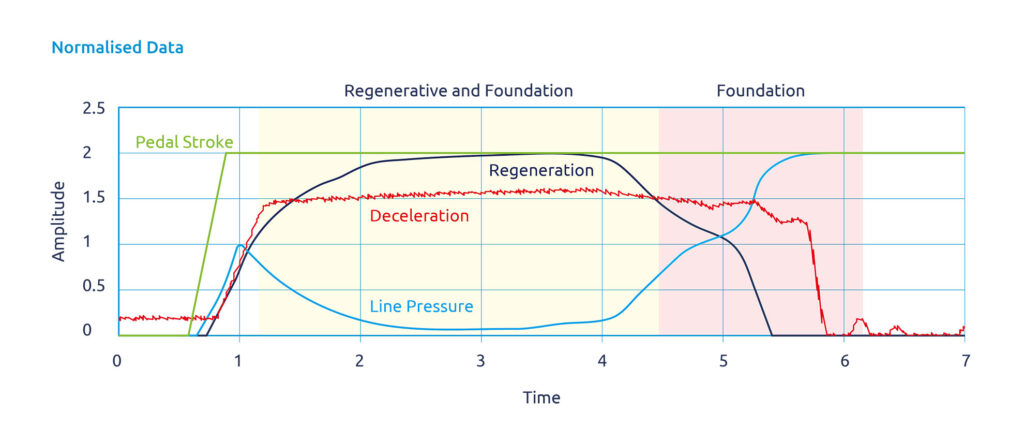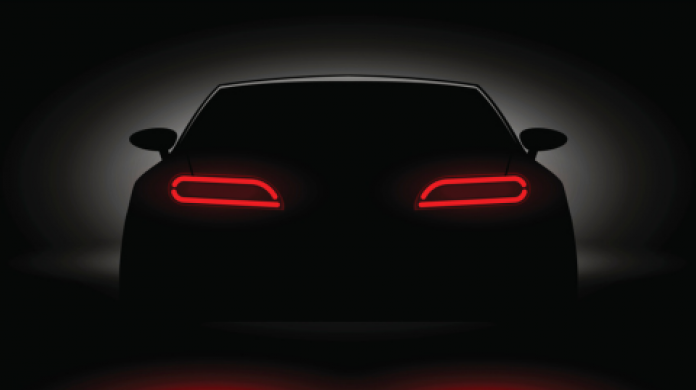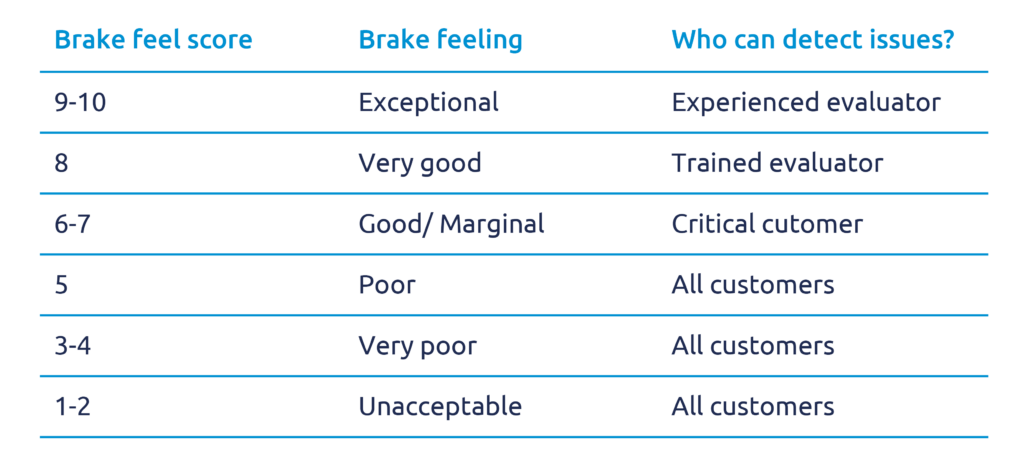In part one of this blog series, the benefits of using objective test data for the development of complex hybrid braking systems were introduced. In this second part, Allan Johnstone, Principal Project Engineer at AB Dynamics uses a working example to detail the methodology.

When the regenerative brake system on an electrified vehicle reaches its limit of deceleration the mechanical foundation brake needs to be blended in to make up the shortfall. Typically, this happens at a deceleration rate of >3m/s2 or when the vehicle’s speed approaches 0 km/h because the braking torque from the electric motor drops off. In these scenarios, where the systems are being blended, brake feel is critical because often the driver can experience varying levels of deceleration for a given demand. This can be disconcerting and result in the driver needing to modulate the brake pedal input, which can exasperate the issue.
Brake feel analysis using brake robots
For the first time, this type of situation can now be objectively tested using our brake feel analysis solution, which incorporates brake robots fitted to the subject vehicle together with control and analysis software. In the following example, the test vehicle is a popular European EV and the test simulated the vehicle coming to a stop approaching a set of traffic lights. This involved an AB Dynamics RBR 600 model brake robot applying the brake to a specific position and holding the pedal constant, until the vehicle came to rest.
From this type of stop, the contribution of the regenerative and the foundation brake can be separated out and visualised (Figure 1).

Figure 1 Visualisation of EV regenerative and foundation brake blending
In Figure 1, the deceleration begins to drop after four seconds. This is generally viewed as a negative characteristic because the driver is required to compensate for the system’s shortfalls by increasing pedal input.
The rating for this type of stop is a relatively low value, which is expected from this level of deceleration reduction during a stop.
This demonstrates that the vehicle has poor brake feel (5.5 on the brake rating index, see part 1) in this scenario as the deceleration reduces despite a constant brake demand. To compensate, the driver must respond by applying more brake stroke. This type of brake characteristic reduces the driver’s level of confidence in the braking system and might even increase the likelihood of low-speed collisions as the driver underestimates the pedal stroke required to stop in time. This is a common issue with EVs as the regenerative braking torque reduces at lower speeds so the foundation brake needs to compensate. If the system fails to do this adequately it will require input from the driver.
Regenerative braking systems are significantly more complex than traditional setups. The development of these systems is still evolving as the technology advances. To accelerate the development, engineers would benefit greatly from a tool that can test, analyse, and evaluate them accurately and repeatably providing valuable objective data.
The AB Dynamics brake robots that are used as part of the brake feel analysis solution provide a level of control to the brake pedal that is beyond that of any driver, with levels of precision that have not been possible before. The repeatable inputs from the brake robots enable the braking system’s performance to be accurately measured, taking into account a reduction in the battery state of charge or a modification in the blending algorithm.
Our solution bridges the gap between objective and subjective evaluation, allowing the user to quickly understand the subjective impact of the braking system providing a visualisation of each braking characteristic and a subjective score. Importantly, this information provides quantitative information that can be shared within and across teams, providing the basis for objective decision-making.
This information will be critical in ensuring that brake feel and performance are to a level expected by consumers, leading to better satisfaction and reduced warranty issues.
Key takeaways
- Hybrid braking systems are complex and challenging to optimise, as they depend on multiple variables such as battery state, friction level, and driving conditions.
- AB Dynamics has developed a solution to objectively test and analyse the brake feel of hybrid vehicles.
- This solution enables engineers to optimise the brake controller, benchmark competitor systems, and validate brake system performance using objective data and subjective feedback.
- A working example of the solution applied to a popular European EV, demonstrates how the contribution of the regenerative and the foundation brake can be separated out and visualised, and how the brake feel rating can be calculated and interpreted.
For more information on our brake development solutions click here or to discuss your programme requirements contact us at info@abdynamics.com
Electric vehicles (EVs) are becoming more popular as they offer many benefits such as lower emissions and reduced fuel costs. However, one of the key challenges that EV manufacturers face is how to ensure that the brake system of their vehicles provides a consistent and comfortable feel for drivers. This is especially important for hybrid systems that combine mechanical and regenerative braking, which can vary depending on the battery state, the friction level, and the driving conditions.

In this blog post, Allan Johnstone, Principal Project Engineer at AB Dynamics discusses a novel solution developed by AB Dynamics that enables objective data analysis of the brake feel of hybrid systems and explains how brake robots, control and analysis software, and a brake rating index can help engineers to optimise the brake controller, benchmark competitor systems, and validate brake system performance.
Winning the EV revolution
The winners of the EV revolution will be those manufacturers that remove, or reduce as much as possible, the barriers to adoption. A fundamental challenge for EV manufacturers has been the integration of complex hybrid braking systems, combining the traditional mechanical foundation brake and the electric regenerative system. Ensuring the brake system feels consistent to what consumers have already become accustomed to is a critical barrier to overcome.
The challenge for engineers is to seamlessly blend the two systems together while maximising regenerative braking to recharge the battery to maximise vehicle range. This is most commonly achieved by using a brake-by-wire system, where the pedal characteristic, stroke and load are provided by a pedal simulator element and the braking demand by a stroke sensor. The brake controller blends the two systems to produce the required deceleration requested by the driver.
Commonly in EVs the driver experiences varying levels of deceleration for the same braking demand, making the brake feeling unpredictable at best, or at worst unsafe, which can lead to costly recalls. This is often caused by the variables within the system, such as the state of charge of the battery and the friction level between disc and pad, which changes with temperature, moisture levels and wear.
Traditionally, brake feel has relied solely on the subjective assessment of brake engineers. In order to change this and to prevent poor brake feel it is key to inject thorough objective test data into the development process. This enables engineers to analyse the braking system at all variable points, optimise the brake controller, assess individual components, accurately benchmark competitor systems, and support subjective feedback that can often be misinterpreted.
AB Dynamics has developed what it believes to be the industry’s first objective brake feel assessment solution that uses brake robots fitted to the subject vehicle together with control and analysis software. Our solution enables the objective testing of a vehicle’s braking system and provides an automated analysis upon completion of the testing. The software uses an algorithm to assess the vehicle’s brake feel based on the SAE brake rating index.

Brake rating index
The data used for the analysis is acquired through our brake robots, which are specifically designed to provide accurate and repeatable applications of the brake pedal. They are widely used by the automotive industry for applications such as testing of ADAS technologies, durability and misuse testing.
The control parameter can be pedal stroke, pedal load, a level of deceleration or a mixture of the three. The result is quantifiable measurements of the vehicle’s brake system across various conditions and vehicle speeds. Our solution automatically assesses a wide range of aspects including stroke effectiveness, load effectiveness, booster reaction and low and high-speed build-up to determine the three key areas that contribute to brake feel: system stiffness, system response and friction characteristics.
AB Dynamics has worked with expert brake system evaluators to convert this objective data into a usable subjective score to provide an instant judgement of overall brake feel. This gives engineers more confidence in assessing and signing off the brake system by knowing that their evaluation is supported by objective data.
Critically, the data produced by our brake feel analysis system also enables the development of an accurate digital model of the braking system for incorporation into vehicle models and virtual validation. The brake feel tool can also be integrated into a Hardware-In-the-Loop (HIL) test rig. This enables the control of the blended braking system to be matured well ahead of a physical prototype vehicle, saving significant time and money.
Key takeaways:
- Brake feel is a critical factor for EV adoption, as consumers expect a consistent and comfortable braking experience.
- Hybrid braking systems are complex and challenging to optimise, as they depend on multiple variables such as battery state, friction level, and driving conditions.
- AB Dynamics has developed a unique solution that enables objective data analysis of the brake feel of hybrid systems, using brake robots, control and analysis software, and brake rating index.
In the next part of this blog series, a working example of AB Dynamics’ assessment tool will be presented. In the meantime, if you want to learn more about our solution and how it can help you improve your EV brake feel, contact us at info@abdynamics.com
